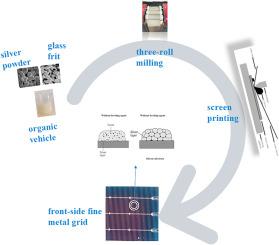TOPCon太阳能电池正面银浆流平与塑性协同调节机制研究
IF 6.3
2区 材料科学
Q2 ENERGY & FUELS
引用次数: 0
摘要
银浆的印刷质量严重依赖于它们的流变性能,特别是对于TOPCon太阳能电池的正面细网格系统。本研究探讨了TOPCon电池正面细网格银浆的印刷质量和流变性的协同优化。采用三级剪切试验(3ITT)和屈服应力测量,我们系统地评估了a型短链硅树脂矫平剂和b型聚丙烯酸酯矫平剂在不同剂量下对浆料初始粘度、触变性、恢复动力学和印刷网格形态的影响。结果表明,加入0.2 wt%的有机硅调平剂(A-S-0.2体系)显著提高了膏体的回收率,在17秒、50 <; 1秒时达到87%的回收率。这种性能明显优于对照组和b系列样品,确保了丝网印刷和预烧结过程中的形态稳定性。连续生产线印刷验证表明,配方A-S-0.23和A-S-0.25的纵横比分别达到28.9%和34.2%。因此,串联电阻降低了19.2% - 26.9%,转换效率从26.19%提高到26.59%。分析表明,该矫直机通过降低颗粒表面能和抑制黏度滞回,实现了“剪切-软化-结构-重建”的精确平衡,从而有效地抑制了横向扩展和形态崩溃。这项工作为高精度细网格打印和高效TOPCon器件的制造提供了基本的设计概念和理论基础。本文章由计算机程序翻译,如有差异,请以英文原文为准。

Investigation of the synergistic regulation mechanism of levelling and plasticity in front-side silver paste for TOPCon solar cells
The printing quality of silver pastes is critically dependent on their rheological properties, particularly for the front-side fine-grid system of TOPCon solar cells. This study investigates the synergistic optimization of printing quality and rheology in front-side fine-grid silver pastes for TOPCon cells. Employing three-stage shear tests (3ITT) and yield stress measurements, we systematically evaluated the effects of A-type short-chain silicone levellers and B-type polyacrylate levellers, across varying dosages, on the paste's initial viscosity, thixotropy, recovery kinetics, and printed grid morphology. Results demonstrate that incorporating 0.2 wt% silicone leveller (A-S-0.2 system) significantly enhances paste recovery, achieving 87 % recovery at 17 s with t50 < 1 s. This performance markedly surpasses both the control group and B-series samples, ensuring morphological stability during screen printing and pre-sintering. Continuous production-line printing verification revealed that formulations A-S-0.23 and A-S-0.25 achieved aspect ratios of 28.9 % and 34.2 %, respectively. Consequently, series resistance was reduced by 19.2 %–26.9 %, and conversion efficiency increased from 26.19 % to 26.59 %. Analysis indicates that the leveller achieves a precise "shear-softening–structural-reconstruction" balance by reducing particle surface energy and suppressing viscosity hysteresis, thereby effectively inhibiting lateral spreading and morphology collapse. This work provides essential design concepts and a theoretical foundation for high-precision fine-grid printing and the fabrication of highly efficient TOPCon devices.
求助全文
通过发布文献求助,成功后即可免费获取论文全文。
去求助
来源期刊

Solar Energy Materials and Solar Cells
工程技术-材料科学:综合
CiteScore
12.60
自引率
11.60%
发文量
513
审稿时长
47 days
期刊介绍:
Solar Energy Materials & Solar Cells is intended as a vehicle for the dissemination of research results on materials science and technology related to photovoltaic, photothermal and photoelectrochemical solar energy conversion. Materials science is taken in the broadest possible sense and encompasses physics, chemistry, optics, materials fabrication and analysis for all types of materials.
 求助内容:
求助内容: 应助结果提醒方式:
应助结果提醒方式:


